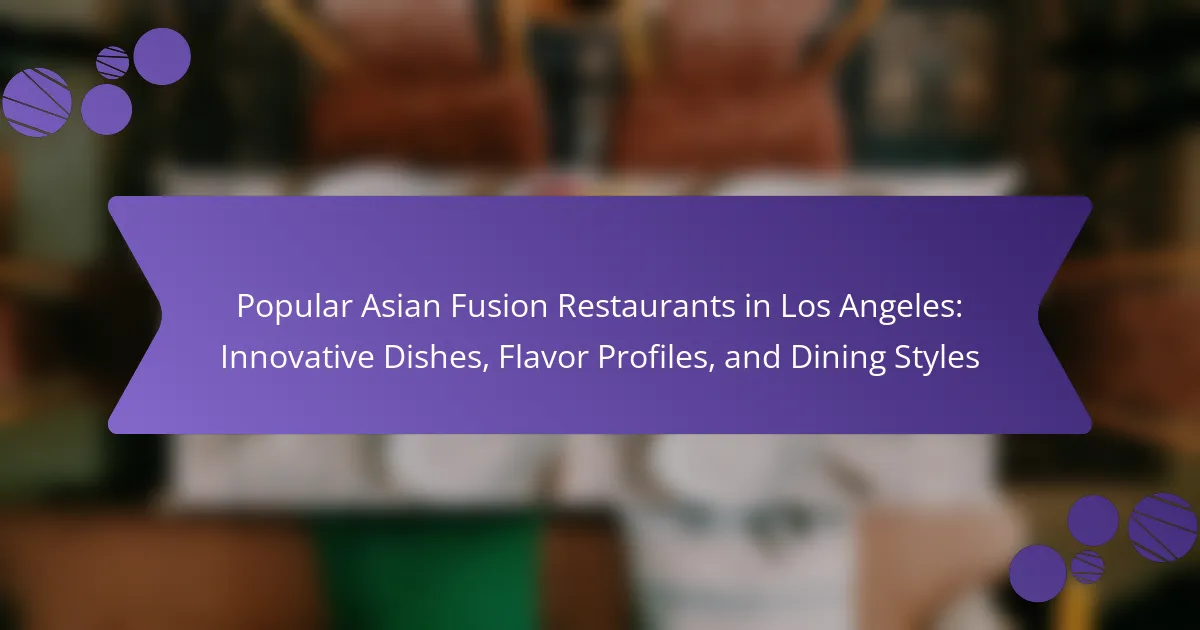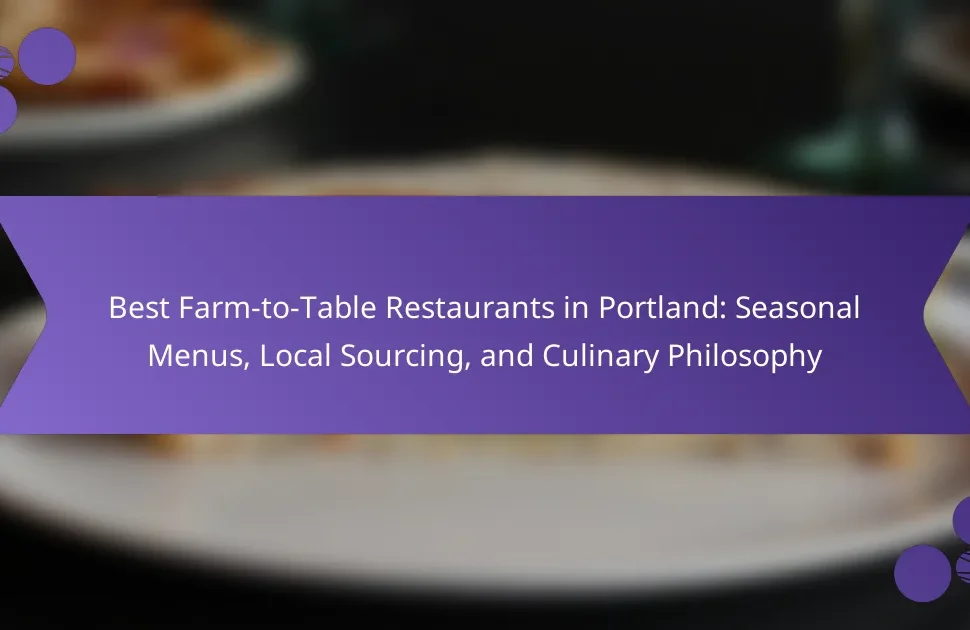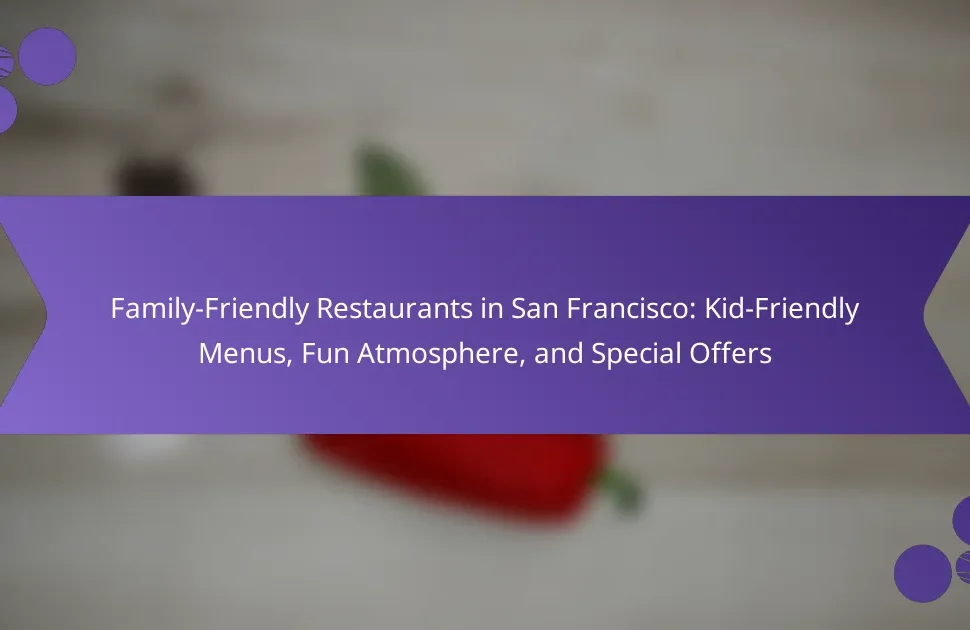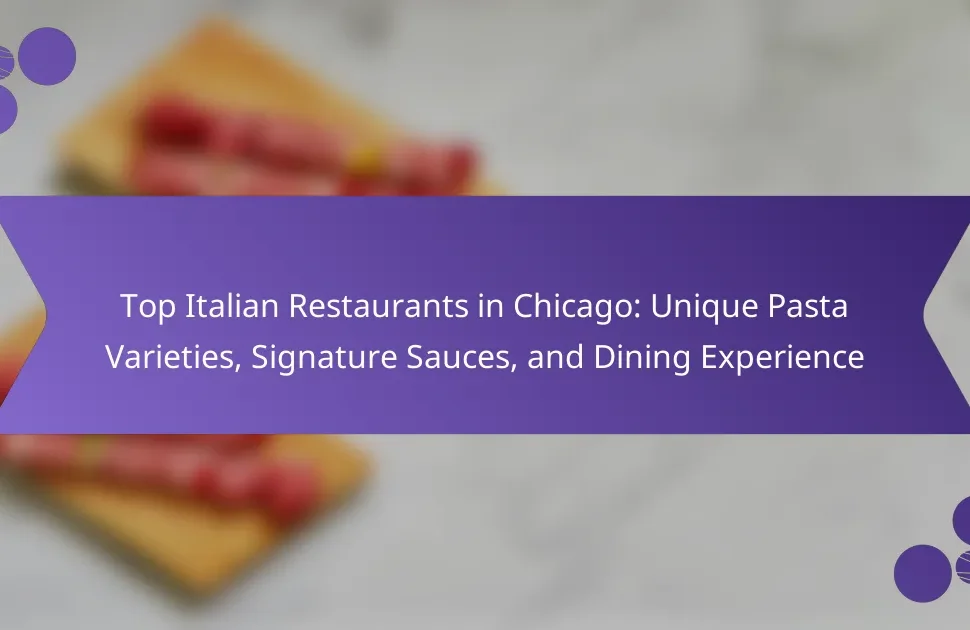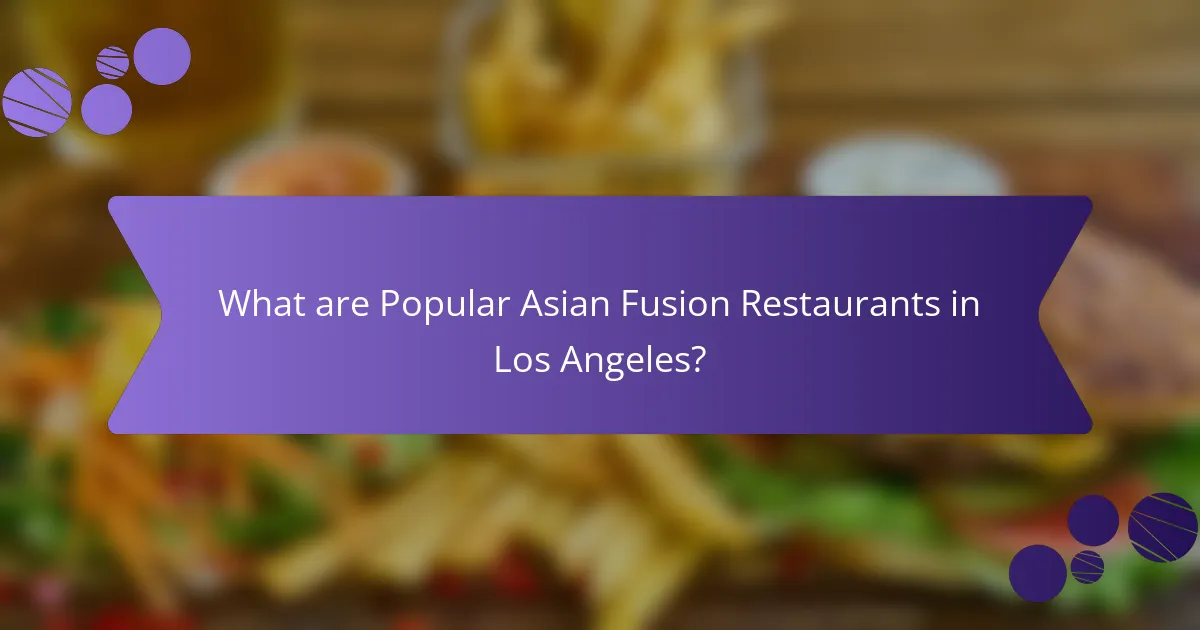
What are Popular Asian Fusion Restaurants in Los Angeles?
Popular Asian fusion restaurants in Los Angeles include Koi, Nobu, and Roy Choi’s Kogi BBQ. Koi offers a blend of Japanese and American cuisine, featuring sushi and grilled dishes. Nobu is renowned for its innovative Japanese-Peruvian dishes, like black cod miso. Kogi BBQ is famous for its Korean tacos, combining Korean flavors with Mexican street food. Other notable mentions are Chado Tea Room, which offers Asian-inspired tea and snacks, and The Bazaar by José Andrés, known for its creative tapas. These restaurants showcase diverse flavor profiles and unique dining experiences in the city.
How did Asian Fusion cuisine evolve in Los Angeles?
Asian Fusion cuisine evolved in Los Angeles through the blending of diverse culinary traditions. The city’s multicultural population contributed to this culinary innovation. In the 1980s, chefs began experimenting with Asian ingredients and techniques in traditional Western dishes. This led to the creation of signature dishes like sushi rolls with non-traditional fillings. The rise of food trucks and casual dining further popularized Asian Fusion. By the 1990s, restaurants specializing in this genre emerged, showcasing unique flavor combinations. Today, Asian Fusion continues to thrive, reflecting Los Angeles’ dynamic food scene and cultural diversity.
What cultural influences shaped Asian Fusion dishes?
Asian Fusion dishes are shaped by a blend of diverse cultural influences. These influences primarily stem from traditional Asian cuisines, including Chinese, Japanese, Thai, and Indian. Each cuisine contributes unique flavors, ingredients, and cooking techniques. For example, Chinese stir-frying techniques are often combined with Japanese sushi elements. Thai spices and herbs frequently enhance dishes, adding complexity and heat. Additionally, Western culinary practices influence presentation and ingredient combinations. The globalization of food culture has accelerated these fusions, particularly in urban areas like Los Angeles. This city serves as a melting pot, where chefs innovate by merging these varied culinary traditions. The result is a dynamic and evolving food scene that reflects cultural diversity.
What are the defining characteristics of Asian Fusion cuisine?
Asian Fusion cuisine combines elements from various Asian culinary traditions with influences from other global cuisines. This style often features a blend of flavors, techniques, and ingredients from countries such as China, Japan, Thailand, and India. Dishes may incorporate unexpected pairings, like sushi tacos or Thai curry pizza. The presentation is often artistic, reflecting both Asian aesthetics and contemporary trends. Asian Fusion restaurants typically emphasize fresh, high-quality ingredients. They may also cater to diverse dietary preferences, offering vegetarian or gluten-free options. The innovation in Asian Fusion cuisine reflects the evolving nature of global culinary practices.
Why are these restaurants considered popular?
These restaurants are considered popular due to their innovative dishes and unique flavor profiles. They blend traditional Asian cuisines with modern culinary techniques. This fusion creates a diverse menu that appeals to a wide audience. Many diners appreciate the creativity and freshness of the ingredients used. High-quality service and vibrant dining environments also contribute to their popularity. Additionally, social media presence and positive reviews enhance their visibility. Many of these restaurants have received awards or accolades, further establishing their reputation. Overall, the combination of exceptional food, atmosphere, and recognition drives their popularity in Los Angeles.
What role does social media play in the popularity of these restaurants?
Social media significantly enhances the popularity of Asian fusion restaurants in Los Angeles. It serves as a platform for sharing visually appealing food images, attracting potential customers. Users frequently post reviews and recommendations, influencing dining choices. Restaurants often engage with customers through promotions and interactive content, fostering loyalty. Hashtags related to specific dishes help increase visibility in search results. Studies show that 70% of consumers are influenced by social media when choosing a restaurant. This dynamic interaction builds a community around the dining experience, further driving popularity.
How do customer reviews impact the reputation of Asian Fusion restaurants?
Customer reviews significantly impact the reputation of Asian Fusion restaurants. Positive reviews enhance credibility and attract new customers. They serve as social proof, influencing potential diners’ choices. Negative reviews can deter customers and damage a restaurant’s image. According to a survey by BrightLocal, 91% of consumers read online reviews regularly. The same survey found that 84% trust online reviews as much as personal recommendations. Thus, customer feedback shapes public perception and can determine the success of Asian Fusion establishments.

What innovative dishes can be found at these restaurants?
It is not possible to provide specific innovative dishes from popular Asian fusion restaurants in Los Angeles without further context or details about the specific restaurants in question. Each restaurant may offer a unique selection of dishes that reflect their individual culinary style and approach to Asian fusion cuisine.
What are some signature dishes that define Asian Fusion in Los Angeles?
Signature dishes that define Asian Fusion in Los Angeles include Korean BBQ tacos, sushi burritos, and Thai curry pizza. Korean BBQ tacos blend marinated meats with traditional taco elements. Sushi burritos wrap sushi ingredients in a large seaweed sheet. Thai curry pizza combines pizza crust with Thai curry sauce and toppings. These dishes reflect the innovative culinary landscape of Los Angeles. They showcase the integration of diverse Asian flavors with local cuisine. Popular restaurants like Kogi BBQ and Sushirrito have popularized these unique offerings. Their success highlights the growing demand for Asian Fusion cuisine in the city.
How do chefs combine traditional Asian flavors with Western techniques?
Chefs combine traditional Asian flavors with Western techniques by infusing classic Asian ingredients into contemporary cooking methods. They often utilize techniques like sous-vide to enhance textures while preserving authentic flavors. For instance, chefs might use miso or soy sauce in marinades for grilled meats. This approach maintains the essence of Asian cuisine while applying Western culinary skills. Additionally, chefs may incorporate Asian spices in dishes like risotto or pasta, creating a unique fusion. The blending of these culinary traditions results in innovative dishes that appeal to diverse palates. This method reflects a growing trend in culinary arts, showcasing the versatility of both cuisines.
What are the most unique dishes offered by top Asian Fusion restaurants?
Top Asian Fusion restaurants offer unique dishes that blend diverse culinary traditions. Examples include sushi tacos, which combine traditional sushi ingredients with a taco shell. Another unique dish is Korean BBQ pizza, merging savory Korean flavors with Italian pizza. Additionally, Thai basil chicken spring rolls introduce a fresh twist on classic spring rolls. These innovative dishes reflect the creativity and cultural fusion found in Asian Fusion cuisine.
How do flavor profiles differ in Asian Fusion cuisine?
Flavor profiles in Asian Fusion cuisine combine diverse culinary traditions. This fusion often blends sweet, salty, sour, and umami flavors. For instance, dishes may incorporate soy sauce, ginger, and sesame oil alongside ingredients like chili and lime. The use of fresh herbs, such as cilantro and basil, adds aromatic elements. Techniques from various Asian cultures, such as stir-frying and steaming, enhance texture and flavor. Additionally, regional influences, like Japanese, Thai, and Chinese, create unique combinations. This results in innovative dishes that appeal to a broad palate. Overall, Asian Fusion cuisine showcases a dynamic interplay of flavors and techniques.
What are the common flavor profiles found in Asian Fusion dishes?
Common flavor profiles in Asian Fusion dishes include sweet, spicy, sour, and savory. These profiles often combine elements from different Asian cuisines. For example, sweetness can come from ingredients like honey or coconut. Spiciness is frequently derived from chili peppers or sriracha. Sour flavors may be introduced through lime or vinegar. Savory notes often come from soy sauce or miso. The blending of these flavors creates unique and innovative dishes. Asian Fusion cuisine emphasizes balance, often integrating contrasting flavors for a harmonious taste experience.
How do various Asian cuisines influence the flavor combinations?
Various Asian cuisines influence flavor combinations through unique ingredients and techniques. Each cuisine introduces distinct elements like herbs, spices, and cooking methods. For example, Thai cuisine emphasizes the balance of sweet, sour, salty, and spicy flavors. This balance creates complex dishes that appeal to diverse palates. Chinese cuisine often incorporates umami through ingredients like soy sauce and fermented products. Japanese cuisine highlights freshness and simplicity, using techniques such as sushi preparation to enhance natural flavors. Indian cuisine adds depth with spices like cumin and coriander, which create rich flavor profiles. The interplay of these diverse influences fosters innovative dishes in fusion restaurants. This culinary blending results in unique flavor combinations that reflect the rich tapestry of Asian traditions.
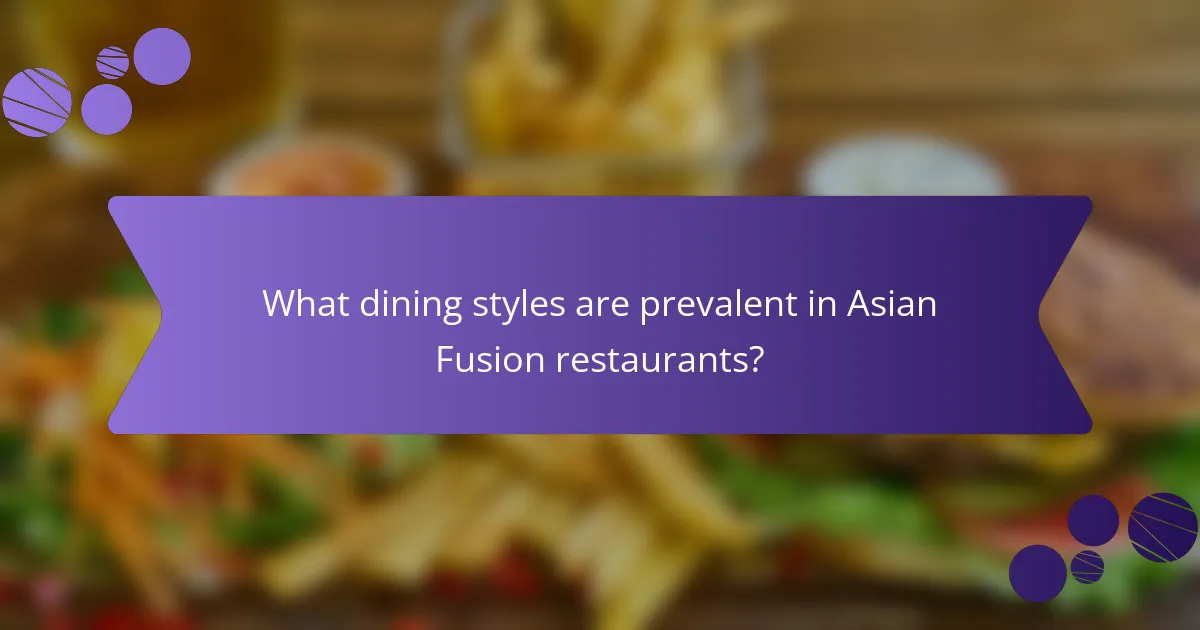
What dining styles are prevalent in Asian Fusion restaurants?
Asian Fusion restaurants commonly feature a variety of dining styles. These include casual dining, fine dining, and buffet options. Casual dining emphasizes a relaxed atmosphere with shared plates and communal seating. Fine dining focuses on an upscale experience with meticulously crafted dishes and attentive service. Buffet dining allows patrons to sample multiple dishes at their own pace. Each style caters to different dining preferences and occasions. Casual dining is popular for its accessibility and social experience. Fine dining attracts those seeking a gourmet culinary adventure. Buffet dining appeals to larger groups wanting variety. These styles reflect the diverse culinary landscape of Asian Fusion cuisine.
What types of dining experiences do these restaurants offer?
Popular Asian fusion restaurants in Los Angeles offer diverse dining experiences. These experiences include casual dining, fine dining, and takeout options. Casual dining features a relaxed atmosphere with shareable dishes. Fine dining emphasizes upscale service and presentation. Many restaurants also provide a unique tasting menu. This menu showcases a variety of innovative dishes. Additionally, some establishments offer a fusion of traditional and modern culinary techniques. The combination of flavors and styles enhances the overall dining experience.
How do casual dining and fine dining differ in Asian Fusion settings?
Casual dining and fine dining in Asian Fusion settings differ primarily in atmosphere, service, and menu complexity. Casual dining offers a relaxed environment with informal service. It typically features a diverse menu that includes accessible Asian Fusion dishes. Fine dining, on the other hand, emphasizes an upscale atmosphere with attentive service. The menu in fine dining often includes elaborate, artistically presented dishes that showcase unique flavor combinations.
Casual dining establishments may prioritize comfort and speed, catering to a broader audience. Fine dining restaurants, however, focus on a curated experience, often requiring reservations and offering tasting menus. The price points also differ significantly, with fine dining generally commanding higher prices due to premium ingredients and presentation.
In Asian Fusion, the blend of culinary traditions can be more pronounced in fine dining, where chefs experiment with intricate techniques. Casual dining may offer fusion dishes that are simpler and more straightforward, appealing to everyday diners. Overall, these differences reflect the distinct dining experiences each setting aims to provide.
What role does ambiance play in the dining experience?
Ambiance significantly influences the dining experience. It encompasses elements like lighting, decor, and music. A well-designed ambiance enhances comfort and enjoyment. Research indicates that 80% of diners consider ambiance important when choosing a restaurant. For instance, dim lighting can create intimacy, while vibrant decor can stimulate appetite. The overall atmosphere can affect diners’ mood and perception of food quality. A positive ambiance often leads to longer visits and increased spending. Thus, ambiance is crucial for attracting and retaining customers in the competitive restaurant industry.
How do these restaurants accommodate dietary preferences?
These restaurants accommodate dietary preferences by offering diverse menu options. They typically provide vegetarian, vegan, gluten-free, and allergen-friendly dishes. Many establishments use clear labeling to indicate these options. Some restaurants customize meals upon request to meet specific dietary needs. Chefs are often trained to handle cross-contamination concerns. For example, they may use separate cooking utensils for allergen-free meals. Additionally, seasonal menus allow for fresh, local ingredient choices. This flexibility enhances the dining experience for various dietary lifestyles.
What options are available for vegetarian and vegan diners?
Vegetarian and vegan diners can find a wide variety of options in Asian fusion restaurants. Common offerings include vegetable sushi rolls, tofu stir-fries, and curry dishes made with coconut milk. Many restaurants also provide salads featuring fresh greens and unique dressings. Vegan versions of traditional dishes, such as pho or ramen, are increasingly available. Additionally, plant-based protein alternatives like tempeh and seitan are often used in meals. Some establishments even offer specialty dishes that highlight seasonal vegetables. These options cater to diverse tastes while ensuring dietary preferences are met. Many Asian fusion restaurants in Los Angeles specifically design their menus to accommodate vegetarian and vegan diets.
How do restaurants cater to gluten-free and other dietary restrictions?
Restaurants cater to gluten-free and other dietary restrictions by offering specialized menus and ingredient transparency. Many establishments provide gluten-free options marked clearly on their menus. They often use gluten-free grains and alternatives in their dishes. Cross-contamination prevention is a priority, with separate cooking equipment and utensils. Staff training on dietary restrictions ensures accurate information is provided to customers. Some restaurants collaborate with nutritionists to create balanced meals. Additionally, many offer customizable dishes to accommodate individual needs. This approach helps meet the demands of diverse dietary preferences and health concerns.
What tips can enhance the dining experience at Asian Fusion restaurants?
To enhance the dining experience at Asian Fusion restaurants, try a variety of dishes. Asian Fusion menus often feature unique combinations of flavors. Sharing plates allows for tasting multiple items, which adds to the experience. Pairing food with appropriate beverages enhances flavors. Consider trying specialty cocktails or teas that complement the meal. Engaging with staff can provide insights into the menu. Ask for recommendations based on personal preferences. Lastly, enjoying the ambiance contributes to the overall experience. A well-decorated space can enhance the enjoyment of the meal.
The main entity of this article is popular Asian fusion restaurants in Los Angeles, which are known for their innovative dishes and unique flavor profiles. The article covers notable establishments such as Koi, Nobu, and Kogi BBQ, highlighting their signature offerings and the cultural influences that shape Asian fusion cuisine. It explores the evolution of this culinary genre, the defining characteristics of Asian fusion dishes, and the role of social media and customer reviews in enhancing restaurant popularity. Additionally, the article discusses various dining styles, dietary accommodations, and tips for maximizing the dining experience at these restaurants.
